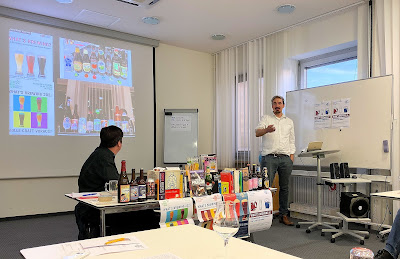The fifth workshop in the series What's Brewing was devoted to beers of the Pilsner type.
While Frank Greeraers was giving the introduction to the event reviewing the past four workshops (Read here about #one, #three, and #four), an American in Prague and co-host, Evan Rail, was attentively watching and listening,
 |
| In Evan Rail's beer guide, you not only find the Pilsner Urquell. |
Evan Rail, the author of The Meaning of craft beer, was the star of the evening. Here is the first information we read in his book, "This sounds unbelievable today, but in 1993 you could actually operate a successful American craft brewery and not serve a hoppy American IPA - or even an IPA of any kind. You could make your bones on the great Pilsner and a delicious Dunkel, with a line out the door on weekends. In its earliest days, American craft beer really did speak with a European accent."
Why shouldn't it? Already in 1840, Bavarian brewers showed the Americans that a fresh lager tasted different from "warm" English-style beers.
Johann Wagner did not call his bottom-fermented beer "Pilsner," as the brewers in Pilsen only learned two years later, in 1842, how to make a lager beer. Again, a Bavarian, Josef Groll from Vilshofen, taught the Pilseners how to brew a cold fermentation beer from a gently kilned and, therefore, very light malt.
Frank called 1840/1842 the years of the Big Bang in beer brewing, Urknall in German, referring to Pilsner Urquell?
In the beginning, the name was protected when, in 1896, German brewers failed to call their lager beer "Pilsner."
Evan even explained the three ways* of pouring a Pilsner Urquell:
*The explanations I found at http://www.biersekte.de/Aktuell/Neuigkeiten/Pilsner-Urquell-Waldmannskost.htm
Hladinka: the beer is tapped under an approx. 3.5 cm high head. This allows the bitter and delicate aromas and hop notes to be felt more intensely on the palate while drinking, making this beer tap a perfect match for meat and fish.
Šnyt: the glass is half-filled* with foam, and then the golden beer is tapped underneath. As the beer is drunk through the head, the malty cereal aromas are particularly intense, while the hop aromas remain in the background.
*In German, we would call the badly poured filling Schlecht eingeschenkt.
Mlíko (milk): here, a glass of beer foam is served. The beer is exceptionally creamy, as the froth makes the sweet caramel aromas of the malt more intense when drunk. This tap is a perfect match for desserts.
 |
| Let us hope that this kind of fraternization will have its comeback one day or aren't there any gentlemen anymore? |
The short story is that in the States, you get US-brewed Budweiser, while in Germany, you can buy original Budvar Budweiser, a mass-produced beer made in Budweis.
The beers tasted
1. Another Civic Brewhouse was founded in Budweis in 1795 by the German-speaking burghers of the Bohemian city. Nowadays, they brew and bottle a quality lager/pilsner beer in České Budějovice that is marketed as Samson. It was the first beer we tasted.
2. A Pilsner style Benedict Pale Lager is brewed by Piovar Břevnovsky in Prague. They claim to be the oldest monastery brewery dating from 993!
3. Bernard Dunkel Lager is brewed by the family brewery in Humpolec in the Czech Republic. This dark beer has a pleasant taste.
4. Raven Waffle Dance Stroopwafel* Ale from the pivovar Raven in Pilsen. A sweet and full-bodied Stroopwafel Ale brewed in collaboration with the Sisters Brewery, Holland. Wafel dance is brewed with Dutch Stroopwafels and Czech dedication. This brew was simply too sweet.
*a wafer cookie made from two thin layers of baked dough joined by a caramel filling
Here is an article by Evan Rail in the NYT. He was affirmative for Berlin beer, but was it because German craft beers now speak with an American accent?
Besides, when everything fails ...
This falling in love resulted in an increased export of craft beer and a beer pairing dinner in Berlin.
Beer instead of ping-pong diplomacy as, e.g., the ...
5. Bohemian Pilsner brewed by Lemke in Berlin. We brewed it with Bohemian malt and plenty of original wort and then stuffed it with Saazer and East-Kent-Golding hops.
 |
| An earlier case of beer diplomacy: Bill with Czech President Václav Havel and a nearly empty glass in Prague |
 |
| With all those Pilsner beers, Evan had to explain their differences. |
The warnings "Consumption of alcoholic beverages impairs your ability to drive a car or operate machinery and may cause health problems" were apparently not taken seriously by US comedian Conan O'Brien ...
... drinking beer the Irish way?
8. Mr. Cinnamon Bun containing cinnamon snail and vanilla extract is mixed by Sudden Death Brewing Company, Timmendorfer Strand, Germany. The motto for the mix is, "Hey ladies, what would you like for breakfast tomorrow?"
9. Luckily enough, the last choice was more serious. We tasted the Baltic Porter Woda Portova craft beer brewed by a German-American Czech group, Yankee & Kraut, and the team from Pivovar Raven.
Here we should not forget the craft beer brewed by the Braukollektiv Freiburg. An American-Australian-German Group has given more than 28 NEIPAs to beer connoisseurs in the region from 2014 to 2019.
Here is the final group photo of the Jagdstrecke (hunting bag) of the beers tasted at a well-organized and well-remembered workshop.
*















No comments:
Post a Comment